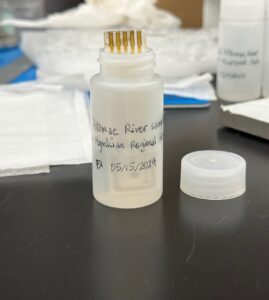Week Eleven: The End of the Beginning
May 17, 2024
Hello, blog!
Welcome to my last blog post. After 11 weeks of researching PFAS, experimenting in the lab, connecting electrodes, keyboard typing, and making and learning from mistakes, I can’t believe we’re finally here.
In this final post, I’ll expand on the experiments with the Potomac River environmental samples I started last week. I continued sensing with my two other water samples: Riverbend Park (Great Falls) and Algonkian Regional Park (Sterling). In effort to minimize the effects of any outside variables, I performed these experiments using the same computer and potentiostat setup in the fume hood and followed the exact procedure I had with the Georgetown Waterfront sample.
This means all of the electrodes are fabricated with a PFOS Water MIP before sensing PFAS in the Potomac River samples. The MIP solution included:
-500 ppm in PFOS in water
-o-PD
-small amount of HCl
Then, after the MIP on the electrode surface was fully prepared and characterized, I placed the electrode in a methanol and water extraction solution to remove the PFOS molecules from the MIP.
For sensing, I first characterize the MIP after it sits in water overnight (which in this case is only 30 minutes because long story short, the extraction solution wasn’t fully extracting the MIP). The electrode sits overnight in a water vial so that any residual methanol on the MIP gets rinsed off. While the characterization was running, I prepared the vial of the desired Potomac Water sample. Since the samples have been sitting in the fridge, they need to warm up to room temperature for the PFAS molecules to diffuse into the MIP imprints because warmer temperatures increase the rate of diffusion.
Then, I let the electrode soak in the same water vial for 40 minutes and characterized immediately after; I performed this step twice. Now, it’s time to place the electrode into the water sample. Like the previous step, I leave it in for 40 minutes and characterize. I’ve included images of this below.


However, because the concentration of PFOS in these samples are unknown, I performed an extra procedure called standard addition in order to trace back the concentration of PFOS present. The idea is to spike the water sample with known concentrations of PFOS, measure the currents after the electrode is exposed to them, and create a calibration curve with the data points to find the unknown concentration. Current is on the y-axis, and concentration on the x-axis; the unknown concentration is the x-intercept.
Thus, I micro-pipetted in 100 ppt of PFOS into the sample, characterized the electrode after it soaked in the PFOS-spiked water vial for 40 minutes, and repeated the same thing with 500 ppt and 1000 ppt PFOS in the sample. Once the data was exported to my laptop, I analyzed the data with RStudio and plotted the points on a scatter plot with Excel. From this first experiment, the sensor seems to be in the ballpark by a factor of ten for sensing the actual amount of PFOS present (referenced from online sources).
I ended the week by performing another trial of the Georgetown Waterfront sample experiment. I want to have at least two trials for all three samples, so I hope to complete the second trials for Riverbend and Algonkian next week. This data will enhance and help me finish my Senior Project paper and presentation.
It’s time to go, and I hope my blog was both interesting and informative. I’ve can confidently say I learned a lot, and I thoroughly enjoyed the entire Senior Project experience. I feel like I’ve also gained lots of valuable experience that I’ll bring with me to my future work.
Even though the official Senior Project is coming to an end, this doesn’t mean my journey with this project/topic is over. My internship will be going on for a couple of more weeks, and I’ll continue following any new updates and research regarding PFAS sensing after my time with this project and MITRE ends. Exactly what that looks like, whether it’s simply through reading online news or picking up similar projects in college, I’m not sure yet, but I’m excited for what the future holds.
Bye for now,
Fiona
Citations
All images: Fiona Xu


Leave a Reply
You must be logged in to post a comment.